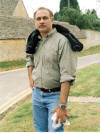|
|
the-south-asian.com July / August 2006 |
|
|||
|
August/September Contents
Sufis - wisdom against 50
years of mountain Heritage cities:
Cotton - the fibre of
|
|
||||
|
Page 4 of 6
Harappan Heritage by Salman Minhas
First published June 2005
Culture, Technology, Trade: Mathematics , Trading Seals & Commercial Trading weights & Raw Materials The Indus Civilization also gave us the 16 annas to a Rupee monetary system, used in south Asian countries until recently, seems to stem from base-8 [ octal] Indus mathematics. Other scholars claim that there was a consistent binary system of weights and measures such that the application of this binary measuring system in architectural features such as brick size was common. The Harappan system of weights established the most frequently occurring weight as 13.63 gms. Taking this weight as 1, the weights found were either fractions or multiples of this weight. [ 1/16, 1/8, ¼, ½, 1, 2, 4, 10, 12.5, 20, 40, 100, 200, 400, 500 and 800]. Evidence of these weights was found in Iraq at Ur [where the Tigris & Euphrates meet], in Bahrain, in Oman. The significance of these weights is that traders from both the Mesopotamian & Harappa civilizations were stationed abroad in both these lands and also in Bahrain [ Dilmun & Saar in northwest Bahrain] and Oman and Dholavira in the Ran of Kutch - Gujarat. Trading Seals signified marks of individual authority/ ownership. They were used in sealing contents of Packages [jars, baskets, containers] and had a small hole on the back which was threaded using a string. At MohenjoDaro, Harappa and Lothal in Gujrat and the main IVC port/export city, bulk goods reprocessing [opening of packages, jars, repackage, sorting, checking] was carried out using these seals. Such seals have been found in Oman, Ur, Susa, Bahrain. Message seals were used to convey /store the information such as the identity of a sender of a message or merchandise or the authority of a particular trading agent carrying the seal. Copper mined out of Oman and Dilmun [Bahrain] became the most heavily traded product between Mesopotamia and the IVC. Lapis and turquoise came from the Chagai hills [scene of Pakistan’s Nuclear Bomb Test site]. Lapis specifically from the Badakhshan province mines in Afghanistan was an alternative source. Modern scholars identify Meluhha with the Indus Valley, Makkan with the Makran and Omani coasts, Dilmun with Bahrain, Failaka, with the adjacent Arabian coastline. These three far-flung lands were important partners in the immense trade network in which Mesopotamia participated. In the major literary references to Harappa – Meluhha includes: - Inscription referring to Meluhhan ships docked at Akkad, a city of Sumerian times in 2330 B.C. -References to a Meluhhan ship-holder and a Meluhhan interpreter. -Gudea of Lagash inscriptions: 'the Meluhhans came up (or down) from their country to supply wood and other raw materials for the construction of the main temple of Gudea?s capital.' -References to luxury items being imported from Meluhha. -References to a Meluhhan workers village. It is fascinating to note that by the Ur III Period [(2112-2004 B.C.], the Meluhhan (Harappan) workers residing in Sumeria had Sumerian names, leading Parpola [ IVC language specialist, University of Helsinki, Finland] to comment that 'three hundred years after the earliest textually documented contact between Meluhha and Mesopotamia, the references to a distinctly foreign commercial people have been replaced by an ethnic component of Ur III society' (Parpola et al. 1977:152). Here we have an undeniable economically-based presence of Indus traders maintaining their own distinct village in a distant peripheral location over a considerable span of time. While this presence does not entail the economic domination necessary for the application of center and periphery models, it is highly intriguing. Once again, the Harappans may not have needed to trade with the west, but there can be no doubt that they did so. In Trading Encounters between the Indus -Valley and Mesopotamia – Babylon, there is little evidence of warfare. The same weights and measures were used for over a thousand miles, an incredible feat in the Bronze Age. Indus traders set up flourishing colonies in the Gulf and Mesopotamia; no evidence of the reverse has yet been found.
|
|||||
|
Copyright © 2000 - 2006 [the-south-asian.com]. Intellectual Property. All rights reserved. |
|||||

